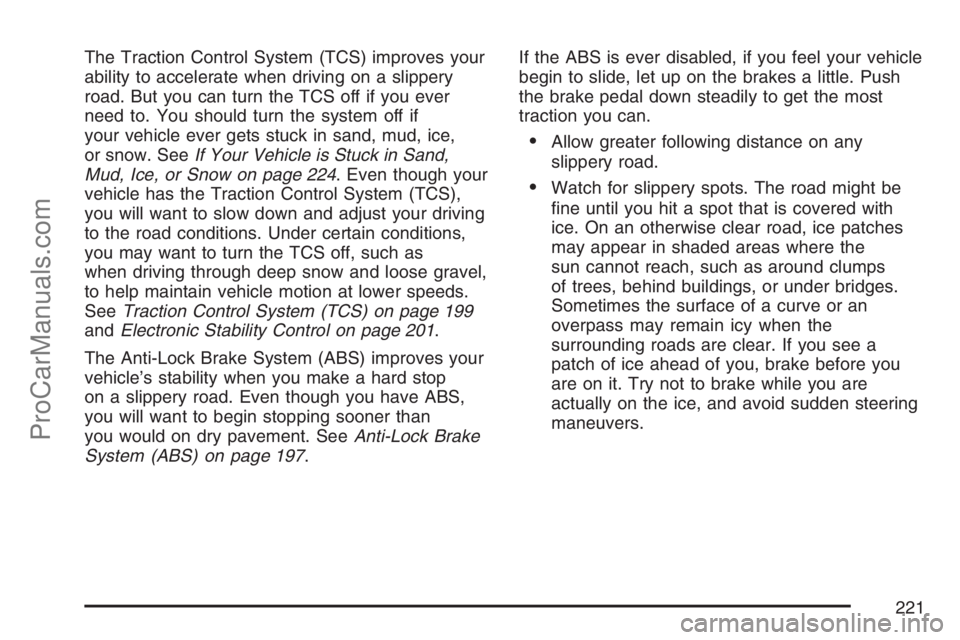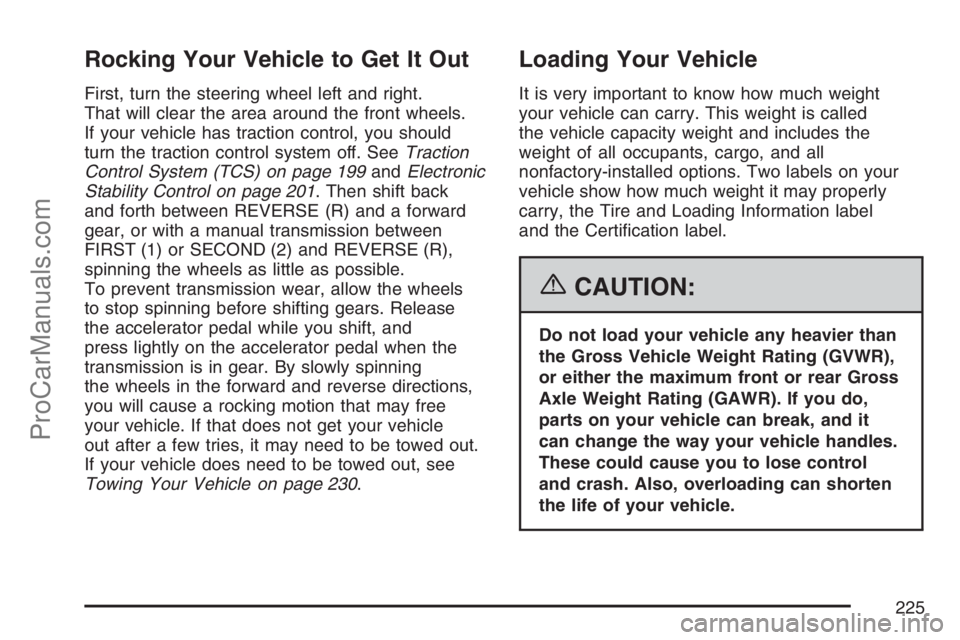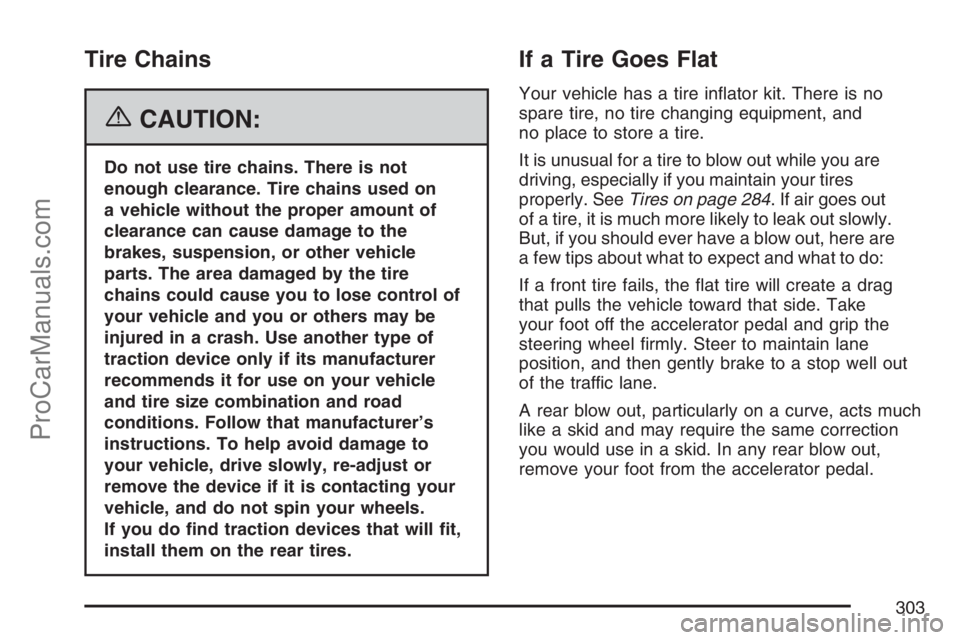steering SATURN SKY 2007 Owner's Guide
[x] Cancel search | Manufacturer: SATURN, Model Year: 2007, Model line: SKY, Model: SATURN SKY 2007Pages: 384, PDF Size: 2.47 MB
Page 221 of 384

The Traction Control System (TCS) improves your
ability to accelerate when driving on a slippery
road. But you can turn the TCS off if you ever
need to. You should turn the system off if
your vehicle ever gets stuck in sand, mud, ice,
or snow. SeeIf Your Vehicle is Stuck in Sand,
Mud, Ice, or Snow on page 224. Even though your
vehicle has the Traction Control System (TCS),
you will want to slow down and adjust your driving
to the road conditions. Under certain conditions,
you may want to turn the TCS off, such as
when driving through deep snow and loose gravel,
to help maintain vehicle motion at lower speeds.
SeeTraction Control System (TCS) on page 199
andElectronic Stability Control on page 201.
The Anti-Lock Brake System (ABS) improves your
vehicle’s stability when you make a hard stop
on a slippery road. Even though you have ABS,
you will want to begin stopping sooner than
you would on dry pavement. SeeAnti-Lock Brake
System (ABS) on page 197.If the ABS is ever disabled, if you feel your vehicle
begin to slide, let up on the brakes a little. Push
the brake pedal down steadily to get the most
traction you can.
Allow greater following distance on any
slippery road.
Watch for slippery spots. The road might be
�ne until you hit a spot that is covered with
ice. On an otherwise clear road, ice patches
may appear in shaded areas where the
sun cannot reach, such as around clumps
of trees, behind buildings, or under bridges.
Sometimes the surface of a curve or an
overpass may remain icy when the
surrounding roads are clear. If you see a
patch of ice ahead of you, brake before you
are on it. Try not to brake while you are
actually on the ice, and avoid sudden steering
maneuvers.
221
ProCarManuals.com
Page 225 of 384

Rocking Your Vehicle to Get It Out
First, turn the steering wheel left and right.
That will clear the area around the front wheels.
If your vehicle has traction control, you should
turn the traction control system off. SeeTraction
Control System (TCS) on page 199andElectronic
Stability Control on page 201. Then shift back
and forth between REVERSE (R) and a forward
gear, or with a manual transmission between
FIRST (1) or SECOND (2) and REVERSE (R),
spinning the wheels as little as possible.
To prevent transmission wear, allow the wheels
to stop spinning before shifting gears. Release
the accelerator pedal while you shift, and
press lightly on the accelerator pedal when the
transmission is in gear. By slowly spinning
the wheels in the forward and reverse directions,
you will cause a rocking motion that may free
your vehicle. If that does not get your vehicle
out after a few tries, it may need to be towed out.
If your vehicle does need to be towed out, see
Towing Your Vehicle on page 230.
Loading Your Vehicle
It is very important to know how much weight
your vehicle can carry. This weight is called
the vehicle capacity weight and includes the
weight of all occupants, cargo, and all
nonfactory-installed options. Two labels on your
vehicle show how much weight it may properly
carry, the Tire and Loading Information label
and the Certi�cation label.
{CAUTION:
Do not load your vehicle any heavier than
the Gross Vehicle Weight Rating (GVWR),
or either the maximum front or rear Gross
Axle Weight Rating (GAWR). If you do,
parts on your vehicle can break, and it
can change the way your vehicle handles.
These could cause you to lose control
and crash. Also, overloading can shorten
the life of your vehicle.
225
ProCarManuals.com
Page 231 of 384

Service........................................................ 233
Accessories and Modi�cations................... 233
California Proposition 65 Warning.............. 234
Doing Your Own Service Work.................. 234
Adding Equipment to the Outside
of Your Vehicle...................................... 235
Fuel............................................................. 235
Gasoline Octane........................................ 235
Gasoline Speci�cations.............................. 236
California Fuel........................................... 236
Additives................................................... 236
Fuels in Foreign Countries........................ 237
Filling the Tank......................................... 238
Filling a Portable Fuel Container............... 240
Checking Things Under the Hood.............. 240
Hood Release........................................... 241
Engine Compartment Overview.................. 242
Engine Oil................................................. 245
Engine Oil Life System.............................. 250
Engine Air Cleaner/Filter............................ 252
Automatic Transmission Fluid.................... 254
Manual Transmission Fluid........................ 254
Hydraulic Clutch........................................ 254Engine Coolant.......................................... 255
Coolant Surge Tank Pressure Cap............ 258
Engine Overheating................................... 258
Cooling System......................................... 260
Power Steering Fluid ................................. 266
Windshield Washer Fluid........................... 267
Brakes...................................................... 268
Battery...................................................... 271
Jump Starting............................................ 272
Rear Axle.................................................... 278
Headlamp Aiming........................................ 278
Bulb Replacement....................................... 279
Halogen Bulbs........................................... 279
Headlamps and Parking Lamps................. 279
Front Turn Signal, Parking and
Fog Lamps............................................ 280
Taillamps, Turn Signal, Stoplamps
and Sidemarker Lamps.......................... 281
Back-Up Lamps......................................... 282
License Plate Lamp................................... 282
Replacement Bulbs................................... 283
Windshield Wiper Blade Replacement....... 283
Section 5 Service and Appearance Care
231
ProCarManuals.com
Page 243 of 384

A. Windshield Washer Fluid Reservoir. See
“Adding Washer Fluid” underWindshield
Washer Fluid on page 267.
B. Coolant Surge Tank and Pressure Cap.
SeeCooling System on page 260.
C. Brake Master Cylinder Reservoir. See
“Brake Fluid” underBrakes on page 268
andHydraulic Clutch on page 254.
D. Engine Oil Dipstick (Out of View). See
“Checking Engine Oil” underEngine Oil
on page 245.
E. Engine Air Cleaner/Filter. SeeEngine
Air Cleaner/Filter on page 252.F. Engine Oil Fill Cap. See “When to Add
Engine Oil” underEngine Oil on page 245.
G. Power Steering Fluid Reservoir. See
Power Steering Fluid on page 266.
H. Remote Negative (−) Ground (Out of View).
SeeJump Starting on page 272.
I. Battery (Out of View). SeeBattery on page 271.
J. Remote Positive (+) Terminal. SeeJump
Starting on page 272.
K. Underhood Fuse Block. SeeUnderhood
Fuse Block on page 328.
243
ProCarManuals.com
Page 245 of 384

A. Windshield Washer Fluid Reservoir. See
“Adding Washer Fluid” underWindshield
Washer Fluid on page 267.
B. Coolant Surge Tank and Pressure Cap.
SeeCooling System on page 260.
C. Brake Master Cylinder Reservoir. See
“Brake Fluid” underBrakes on page 268
andHydraulic Clutch on page 254.
D. Engine Oil Dipstick. See “Checking Engine
Oil” underEngine Oil on page 245.
E. Engine Air Cleaner/Filter. SeeEngine
Air Cleaner/Filter on page 252.
F. Engine Oil Fill Cap. See “When to Add
Engine Oil” underEngine Oil on page 245.
G. Power Steering Fluid Reservoir. See
Power Steering Fluid on page 266.
H. Remote Negative (−) Ground (Out of View).
SeeJump Starting on page 272.
I. Battery (Out of View). SeeBattery on page 271.
J. Remote Positive (+) Terminal. SeeJump
Starting on page 272.
K. Underhood Fuse Block. SeeUnderhood
Fuse Block on page 328.Engine Oil
Checking Engine Oil
It is a good idea to check the engine oil every time
you get fuel. In order to get an accurate reading,
the oil must be warm and the vehicle must be
on level ground.
The engine oil dipstick handle is a yellow loop.
SeeEngine Compartment Overview on page 242
for the location of the engine oil dipstick.
1. Turn off the engine and give the oil several
minutes to drain back into the oil pan. If you
do not do this, the oil dipstick might not
show the actual level.
2. Pull the dipstick and clean it with a paper
towel or cloth, then push it back in all the
way. Remove it again, keeping the tip down
and check the level.
245
ProCarManuals.com
Page 266 of 384

Power Steering Fluid
SeeEngine
Compartment
Overview
on page 242
for reservoir
location.
When to Check Power Steering Fluid
It is not necessary to regularly check power
steering �uid unless you suspect there is a
leak in the system or you hear an unusual noise.
A �uid loss in this system could indicate a
problem. Have the system inspected and repaired.
How to Check Power Steering Fluid
To check the power steering �uid, do the following:
1. Turn the key off and let the engine
compartment cool down.
2. Wipe the cap and the top of the reservoir clean.
3. Unscrew the cap and wipe the dipstick with a
clean rag.
4. Replace the cap and completely tighten it.
5. Remove the cap again and look at the
�uid level on the dipstick.
The level should be between the COLD and
HOT marks. If necessary, add only enough �uid
to bring the level up to the COLD mark.
What to Use
To determine what kind of �uid to use, see
Recommended Fluids and Lubricants on page 345.
Always use the proper �uid. Failure to use the
proper �uid can cause leaks and damage hoses
and seals.
266
ProCarManuals.com
Page 289 of 384

Tire Terminology and De�nitions
Air Pressure:The amount of air inside the tire
pressing outward on each square inch of the
tire. Air pressure is expressed in pounds
per square inch (psi) or kilopascal (kPa).
Accessory Weight:This means the combined
weight of optional accessories. Some examples of
optional accessories are, automatic transmission/
transaxle, power steering, power brakes, power
windows, power seats, and air conditioning.
Aspect Ratio:The relationship of a tire’s height
to its width.
Belt:A rubber coated layer of cords that is
located between the plies and the tread. Cords
may be made from steel or other reinforcing
materials.
Bead:The tire bead contains steel wires wrapped
by steel cords that hold the tire onto the rim.
Bias Ply Tire:A pneumatic tire in which the
plies are laid at alternate angles less than
90 degrees to the centerline of the tread.Cold Tire Pressure:The amount of air pressure
in a tire, measured in pounds per square
inch (psi) or kilopascals (kPa) before a tire has
built up heat from driving. SeeIn�ation - Tire
Pressure on page 292.
Curb Weight:This means the weight of a motor
vehicle with standard and optional equipment
including the maximum capacity of fuel, oil, and
coolant, but without passengers and cargo.
DOT Markings:A code molded into the sidewall
of a tire signifying that the tire is in compliance
with the U.S. Department of Transportation (DOT)
motor vehicle safety standards. The DOT code
includes the Tire Identi�cation Number (TIN),
an alphanumeric designator which can also identify
the tire manufacturer, production plant, brand,
and date of production.
GVWR:Gross Vehicle Weight Rating. See
Loading Your Vehicle on page 225.
GAWR FRT:Gross Axle Weight Rating for the
front axle. SeeLoading Your Vehicle on page 225.
GAWR RR:Gross Axle Weight Rating for the
rear axle. SeeLoading Your Vehicle on page 225.
289
ProCarManuals.com
Page 303 of 384

Tire Chains
{CAUTION:
Do not use tire chains. There is not
enough clearance. Tire chains used on
a vehicle without the proper amount of
clearance can cause damage to the
brakes, suspension, or other vehicle
parts. The area damaged by the tire
chains could cause you to lose control of
your vehicle and you or others may be
injured in a crash. Use another type of
traction device only if its manufacturer
recommends it for use on your vehicle
and tire size combination and road
conditions. Follow that manufacturer’s
instructions. To help avoid damage to
your vehicle, drive slowly, re-adjust or
remove the device if it is contacting your
vehicle, and do not spin your wheels.
If you do �nd traction devices that will �t,
install them on the rear tires.
If a Tire Goes Flat
Your vehicle has a tire in�ator kit. There is no
spare tire, no tire changing equipment, and
no place to store a tire.
It is unusual for a tire to blow out while you are
driving, especially if you maintain your tires
properly. SeeTires on page 284. If air goes out
of a tire, it is much more likely to leak out slowly.
But, if you should ever have a blow out, here are
a few tips about what to expect and what to do:
If a front tire fails, the �at tire will create a drag
that pulls the vehicle toward that side. Take
your foot off the accelerator pedal and grip the
steering wheel �rmly. Steer to maintain lane
position, and then gently brake to a stop well out
of the traffic lane.
A rear blow out, particularly on a curve, acts much
like a skid and may require the same correction
you would use in a skid. In any rear blow out,
remove your foot from the accelerator pedal.
303
ProCarManuals.com
Page 304 of 384

Get the vehicle under control by steering the way
you want the vehicle to go. It may be very
bumpy and noisy, but you can still steer. Gently
brake to a stop, well off the road if possible.
If a tire goes �at, avoid further tire and wheel
damage by driving slowly to a level place
and stopping. Then do this:
1. Turn on the hazard warning �ashers. See
Hazard Warning Flashers on page 110.
2. Park your vehicle. If your vehicle has an
automatic transmission, set the parking
brake �rmly and put the shift lever in
PARK (P). SeeShifting Into Park (P)
(Automatic Transmission) on page 87.
If your vehicle has a manual transmission,
move the shift lever to REVERSE (R) and
set the parking brake �rmly. SeeParking
Your Vehicle (Manual Transmission) on
page 89for additional information.
3. Turn off the engine.
4. Inspect the �at tire.If the tire has been separated from the wheel
or has damaged sidewalls or large tears that
allow rapid air loss, call a tire repair facility. See
Roadside Assistance Program on page 359.
If the �at tire is due to a slow leak caused by a
nail or other similar road hazard, the tire in�ator
kit may be used to repair the damaged tire
temporarily. The kit uses a liquid tire sealant to
seal small punctures in the tread area of the tire.
After repairing a tire with the tire in�ator kit,
take your vehicle to an authorized Saturn retailer
to have the tire inspected and repaired as
soon as possible. The tire sealant is a temporary
repair only. SeeTire In�ator Kit on page 304.
Tire In�ator Kit
Your vehicle has a tire in�ator kit. There is no jack
or spare tire. The kit uses a liquid tire sealant
and air at the same time to seal small punctures
in the tread area of the tire. Be sure to read
and follow all of the tire in�ator kit instructions.
The kit includes the following:
304
ProCarManuals.com
Page 327 of 384

Fuses Usage
6 Ampli�er
7 Cluster
8 Ignition Switch, PassKey III+
9 Stoplamp
10Climate Control System,
PassKey III+
11 Empty
12 Spare
13 Airbag
14 Spare
15 Wiper
16Climate Control System,
Automatic Occupant Sensing
Module, Clutch Switch, Crank
Relay, Instrument Panel Cluster
17 Empty
18 EmptyFuses Usage
19Electric Power Steering,
Steering Wheel Controls
20 Spare
21 Spare
22 Empty
23 Radio
24 Sensing and Diagnostic Module
25Engine Control Module,
Transmission Control Module
26 Door Locks
27 Interior Lamps
28 Steering Wheel Control Backlighting
29 Power Windows
30 Climate Control System
31 Empty
32 Retained Accessory Power
327
ProCarManuals.com